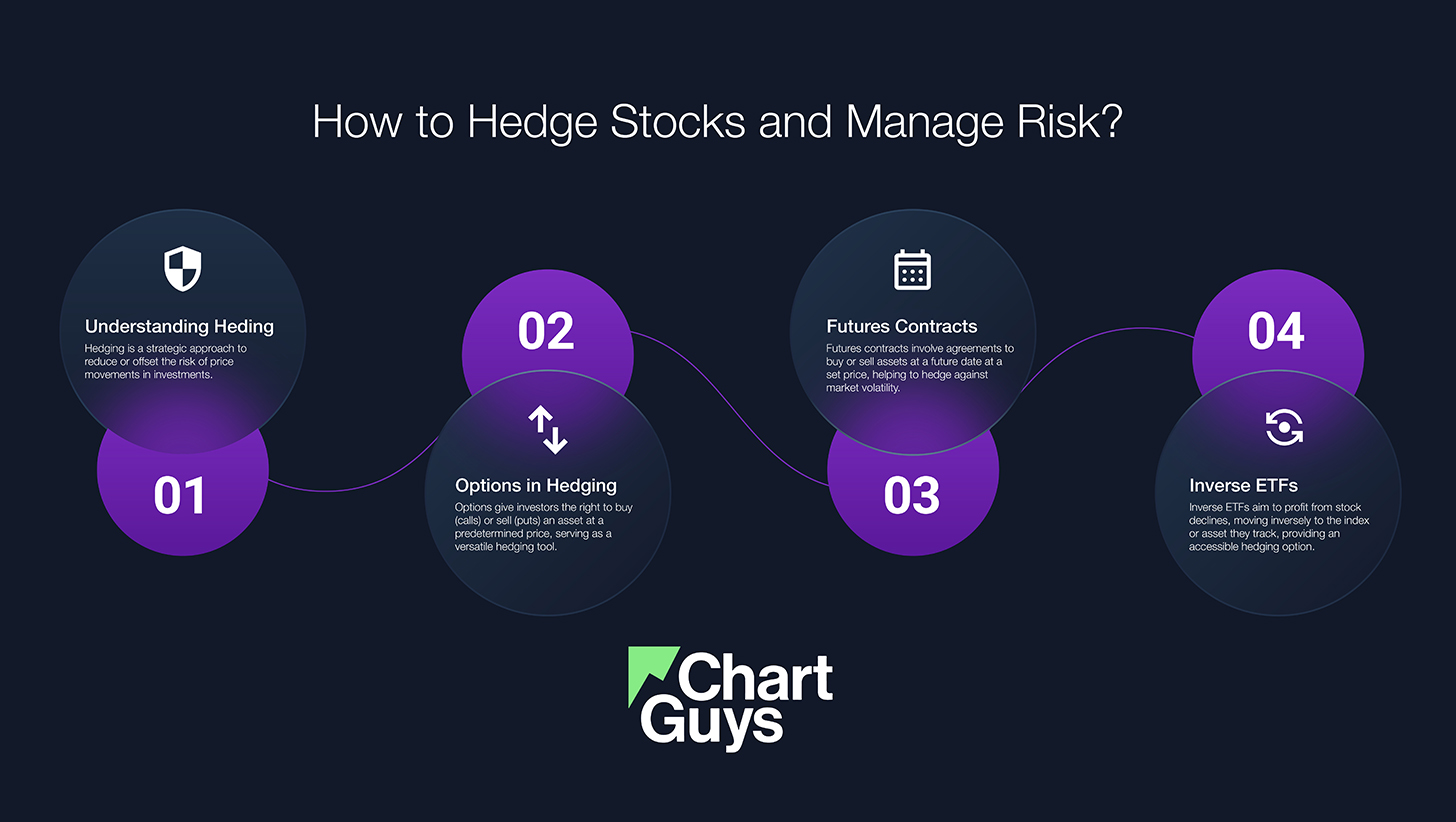How to Hedge Stocks
No, hedging isn't just for hedge funds. Almost anyone from portfolio managers to individual retail traders can benefit from hedging against market corrections. In fact, almost all investors can hedge! But what exactly is hedging, and how can it be used to navigate the complexities of the stock market? In this article, we will explore the concept of hedging and its applications in managing risk when it comes to stock investments. Whether you are an experienced investor or just starting your journey understanding how to reduce risk in the stock market can provide individual investors with valuable tools to safeguard your portfolio.
What is Hedging and How Does it Work?

Portfolio hedging is an investment risk management strategy employed by investors and businesses to safeguard their assets and investments from potential losses. It acts as a form of insurance, helping to mitigate the impact of adverse stock price movements and market fluctuations. The main objective of hedging is to minimize market risk and stabilize returns, particularly when faced with volatile market conditions.
Hedging works by creating a counterbalancing position to offset potential losses from an existing investment. This is done through various methods, such as entering into derivative contracts, options, futures, or diversifying investments across different asset classes. By establishing a hedge, investors aim to reduce the impact of adverse stock price movements on their portfolios.
To grasp the concept of hedging in action, let's consider a practical example. Imagine an investor holds a significant position in a particular stock but anticipates a potential market downturn. To protect against potential losses, the investor may decide to purchase put options, which provide the right to sell the stock at a certain price. If the stock's value indeed decreases, the put options will increase in value, effectively offsetting the losses incurred from the original stock position.
Hedging strategies can take various forms based on specific investment objectives and risk management needs. Diversification is one widely-used approach, involving spreading investments across different asset classes, sectors, or geographic regions. By diversifying, investors can reduce the impact of market fluctuations on their overall portfolios.
Other popular hedging techniques involve utilizing options and futures contracts. These contracts obligate the parties involved to buy or sell an asset at a predetermined price on a future date. By engaging in futures contracts, investors can mitigate the risk of adverse price movements and secure more predictable outcomes. Options contracts also play a role in hedging. Investors can purchase call options, which grant the right to buy an asset at a predetermined price, or put options, which grant the right to sell an asset at a predetermined price. These options act as a safeguard against potential price fluctuations and provide investors with greater flexibility.
Should You Hedge? Trading Strategies and Decision-Making
Determining whether to employ hedging strategies requires careful evaluation, advanced trading techniques, and informed decision-making. It involves assessing your individual investment strategy, risk tolerance, and specific objectives. While hedging can offer benefits in managing risks, it is crucial to consider its potential impact on your portfolio and overall investment approach.
To effectively evaluate whether hedging is suitable for you, start by assessing the need for risk management in your investment strategy. Consider the level of risk you are willing to tolerate and your long-term goals. Hedging can provide a sense of security and stability in times of market uncertainty, but it is essential to align it with your investment objectives.
Advanced trading strategies play a crucial role in hedging decisions. Going beyond basic techniques, such as diversification, it allows for a more tailored approach to managing risk. This may involve exploring derivative contracts, options strategies, or dynamic portfolio management techniques. By leveraging advanced trading strategies, you can optimize your hedging approach and potentially enhance your risk-adjusted returns. In short, hedging is an important part of managing a diversified portfolio.
Assessing the need for hedging in your investment strategy
Determining whether to hedge or not as a trader requires assessing your specific circumstances. Consider the level of risk in your portfolio and the potential impact of market fluctuations. Evaluate your long-term objectives and determine if preserving capital or reducing downside risk is a priority. Additionally, analyze current market conditions and anticipate potential risks. Assess the costs associated with hedging, such as transaction fees and the opportunity cost of limiting potential gains. Seek guidance from financial professionals or advisors who can provide insights tailored to your trading needs. Regularly review and adjust your hedging strategy as market conditions evolve. Ultimately, the decision to hedge should be based on a thorough evaluation of your individual situation and goals.
Exploring Hedging Strategies & Advantages

Implementing effective risk management strategies is crucial for investors and businesses to protect their assets and navigate uncertain environments. Diversification is a strategy that involves spreading investments across different assets, sectors, and regions to minimize risk. Hedging, on the other hand, uses financial instruments like derivatives or options to offset potential losses. Asset allocation involves strategically distributing investments based on risk tolerance and time horizon. Conducting thorough risk assessments and analyses helps identify potential risks and develop appropriate mitigation strategies. Stop-loss orders can limit losses by automatically selling assets at predetermined levels. Developing contingency plans and acquiring suitable insurance coverage are additional risk management measures. These strategies offer advantages such as protection against losses, improved decision-making, enhanced financial stability, confidence, and the potential for optimized returns. By adopting these risk management approaches, individuals and businesses can proactively address risks, protect their assets, and navigate uncertainties with greater peace of mind.
Hedging as a risk management tool
Hedging serves as a valuable risk management tool with various applications. To utilize hedging effectively, follow these key steps:
Begin by identifying the specific risks you want to address, such as market volatility or currency fluctuations. Then, choose suitable hedging instruments that align with those risks, such as options or futures contracts. Determine the appropriate size of your hedge position and consider the desired duration of the hedge, whether short-term or long-term. Continuously monitor and adjust your hedge positions based on market conditions and risk assessments. Evaluate the costs and benefits associated with your hedging strategies, including transaction costs and potential impact on gains. Seek professional advice when needed to ensure the most effective use of hedging in your risk management approach. While hedging does not eliminate all risks, when employed thoughtfully, it can help mitigate potential losses and provide stability to your portfolio.
Real-world example of hedging: Using PUTS to hedge SPY
One example of a successful hedge of SPY (the SPDR S&P 500 ETF) is using put options to protect against a potential market decline. Let's imagine an investor holds a substantial position in SPY but anticipates a potential downturn in the market. In this scenario, the investor could purchase put options on SPY.
Suppose the investor purchases put options with a lower strike price, slightly below the current market price of SPY. If the market indeed experiences a decline, the value of the put options would increase. This increase in value helps offset the losses incurred from the original SPY position, acting as a hedge.
For instance, let's say an investor holds 1,000 shares of SPY. They decide to purchase put options with a strike price of $400 per share. If the market declines and the price of SPY drops to $380 per share, the put options could increase in value. The profit gained from the put options can then help mitigate the losses incurred from the decline in the SPY shares.
By implementing this put options hedge, the investor has effectively protected their SPY position against potential market losses. The put options act as a form of insurance, providing a degree of security and offsetting the downside risk
Real-world example of hedging: Using an Inverse ETF to hedge QQQ
Let's consider a real-world example of hedging using inverse ETFs to protect against potential downside risk in QQQ, the ETF that tracks the performance of the Nasdaq-100 Index.
Suppose an investor holds a substantial position in QQQ but anticipates a potential market downturn in the technology sector. To hedge against this downside risk, the investor could utilize inverse ETFs that aim to deliver the opposite performance of QQQ.
Inverse ETFs are designed to generate returns that are inversely correlated to the underlying index. In this case, the investor could look for an inverse ETF that tracks the Nasdaq-100 Index, aiming to offset potential losses incurred from QQQ if the technology sector experiences a decline.
For instance, if QQQ were to decrease by 5%, the inverse ETF designed to deliver the opposite performance could potentially increase by a similar percentage, thus offsetting the losses in the QQQ position. This hedge can provide a degree of protection and help mitigate the impact of a market downturn on the investor's portfolio.
Choosing a Hedging Instrument and Strategy

When it comes to hedging stocks, several instruments and trading strategies can be employed. The choice of instruments and strategies depends on factors such as the specific risk exposure, market conditions, and individual preferences. Here are some commonly used instruments and strategies for hedging stocks:
Put/Call Options:
Purchasing put options give you the right to sell the underlying stock at a predetermined price (strike price) within a specific timeframe. Put options act as a hedge by providing protection against potential downside movements in stock prices. Calls can be employed for hedging strategies in a different manner than put options. Rather than providing downside protection, calls can help mitigate the risk of missing out on potential upside gains. Two common approaches for using calls in hedging are the covered call strategy and the protective call strategy.
In the covered call strategy, investors own the underlying stock and simultaneously sell call options on that stock. By selling calls, investors generate income from the premium received, which acts as a hedge against potential downside risk in the stock.
On the other hand, the protective call strategy is used by investors who hold a substantial long position in a stock and want to protect against a potential decline. They purchase call options on the same stock to partially offset potential losses in the stock position.
ETFs (Exchange-Traded Funds):
Hedging can also be accomplished using inverse ETFs, which aim to provide the opposite performance of a specific index or sector. By investing in inverse ETFs, investors can effectively hedge against declines in the corresponding underlying stocks or sectors. This is the most popular choice for most retail traders as it allows you directly correlate your stock's price with the underlying assets price and maintain control of your entire portfolio. This hedging technique can be as simple as purchasing an inverse index ETF like SPDN, making one investment to hedge an existing position.
Futures:
Utilizing and trading index futures contracts allows investors to hedge their stock portfolio by taking positions in said futures contracts based on an underlying asset, such as a stock index like the S&P 500. Index futures can help offset potential losses in the overall market by aligning the hedge with the portfolio's broader performance. Most investors do not have access to futures contract trading so this can be considered a more advanced method for hedging.
In summary...

In summary, hedging strategies are essential for managing certain risks in investment portfolios. Investors have various tools and techniques at their disposal to protect against potential losses and navigate uncertain market conditions. Put options act as a form of insurance by allowing investors to sell an asset at a predetermined price within a specified timeframe. Inverse ETFs offer an opportunity to hedge against specific sectors or indices, aiming to generate returns that move opposite to the underlying market. Calls, on the other hand, can be used for hedging by implementing strategies like covered calls or protective calls. Diversification, stop-loss orders, and trend-following strategies also contribute to effective risk management. By carefully assessing risks, selecting appropriate hedging instruments, and staying informed about market trends, investors can establish a solid risk management framework. Seeking advice from professionals can provide valuable guidance when implementing successful hedging strategies. Ultimately, hedging serves as a valuable tool to protect investments, manage risk, and enhance long-term portfolio performance.
Hedging: Protecting a Portfolio
A video by ChartGal-Dinz


